Abstract
Various artificial materials and facilities are sources of microplastics, including artificial turf sports fields. In artificial turf fields, polyethylene fibers are attached to a basal cloth with adhesives. In the present study, we investigated whether the fibers in the field were detached from the basal cloth or torn in the field, and whether they moved to the surrounding ditches that were connected to sewage pipes. In the field, we collected fibers shorter in length compared to the original and these were free from basal cloth, indicating the tearing of the fibers due to players’ activities. We also collected fibers from the ditches, which indicated a migration of the fibers from the field into the ditches. These results suggest that the fibers in ditches could enter sewage treatment plants and be released into the aquatic environment as microplastics. We also examined whether goldfish, Carassius auratus, ingested these fibers, and observed that the fish ingested them with feed while the fish did not without feed. These results indicate that the fiber ingestion by the fish occurred unintentionally when they swallowed their feed. The present study demonstrated that artificial turf fibers in sports fields could turn into microplastics that can be ingested by wild fishes.
1. Introduction
Marine and freshwater microplastics (MPs) are a global environmental issue requiring urgent measures [1,2,3,4,5,6,7]. The term MP refers to plastic particles smaller than 5 mm in diameter. Apart from traditional plastics, rubber tips (RTs) such as those from tire wear particles and rubber granule infills in artificial turf sports fields are categorized as MPs [8]. Microplastics are considered to have a negative impact on aquatic ecosystems and organisms. Microplastics have been found in the alimentary canals of wild fishes, including commercial fishes [9,10,11,12], raising concerns about food safety [13]. Laboratory studies have demonstrated the toxicological effects of MPs on fish, including lesions, inflammation, and changes in microbiota of the intestine [14,15,16]. These can result in a decrease in the population size of wild fishes and an increase in concerns about food safety.
Microplastics are released from various sources such as litter, construction waste, agricultural plastic film, tires, fishing gear, and artificial turfs [1]. Previous studies have indicated artificial turf sports fields (ATSFs) to be an origin of MPs [17,18,19,20,21]. The artificial turf sports field consists of artificial turf fibers (ATFs, synthetic grass) and RTs used for the absorption of shocks generated due to player activities on the field. Rubber tips can migrate from these sports fields to the surrounding environment through wind, rain, and players’ activities and eventually enter the aquatic environment as MPs. Our previous experiments have demonstrated that goldfish, Carassius auratus, Japanese crucian carp, Carassius auratus subsp. 2, and rainbow trout, Oncorhynchus mykiss, ingest RTs in the presence as well as absence of feed under laboratory conditions [20,21], suggesting that wild fishes can ingest RTs present in the aquatic environments. These results led us to consider that sports facilities could be one of the sources of MPs and we need to take measures to stop the migration of RTs from ATSFs to aquatic environments.
Compared with studies on RTs as a MP, the impacts of ATFs on the environment are largely unknown. There are two types of artificial turfs: artificial turfs (lawn) without RT infills, used for private yards and private open outdoor spaces [22]; and artificial turfs for sports fields consisting of RT infills [20]. When ATFs are detached or torn, they enter the surrounding environment, including the aquatic environment, as MPs.
Green plastic fibers that have washed ashore have been collected from Japanese and Indian beaches during field surveys [17,23,24,25,26]. Green fibers have also been found in the alimentary canals of marine fishes [27]. The source of these fibers appears to be artificial turfs, but whether they are sports fields or private yards remains unclear. However, they have been released into the environment and turned into marine MPs.
In extension to our previous studies on the RTs from ATSFs [20,21], we focused on the fibers of ATSFs in the present study. The objective of the present study was to examine whether the fibers of ATSFs could end up as marine MPs. Unlike the RTs of ATSFs, ATFs are tightly attached to the basal cloth with an adhesive [20] and there are no free fibers when the ATSFs are installed. However, based on our preliminary observations, free-turf fibers were observed in and around the field. It is assumed that these free fibers are released into the environment as MPs.
In this study, we first surveyed the presence of free fibers in an ATSF and measured the length of the collected free fibers to determine whether the fibers were detached from the basal cloth or torn off. Next, we observed the migration of fibers from the field to the surrounding ditches connected to sewage pipes. Thirdly, we examined whether goldfish, Carassius auratus, a model species, ingest ATFs to study the possibility that wild fishes could ingest ATFs present in the rivers and oceans.
2. Materials and Methods
2.1. Structure of the Artificial Turf Sports Field of International Christian University
A schematic diagram of the ground plan of the ATSF at the International Christian University (ICU) is shown in Figure 1. The field was surrounded by ditches, and three drains were connected to sewage pipes. The artificial turf sports field was installed in 2013 by the Japanese company A (Tokyo, Japan). Fibers of the artificial turf were made of polyethylene (information from the Japanese company A) that can float on water. A schematic diagram of a cross-section of the ATSF of the ICU was previously shown by Chiba et al. [20].
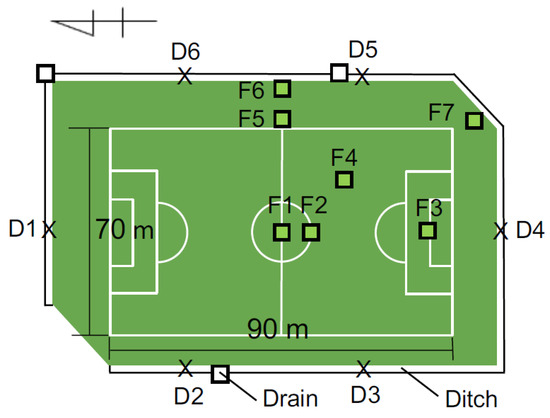
Figure 1.
A schematic diagram of the ground plan of artificial turf sports field of International Christian University. There are ditches along four sides of the field. Open squares on the ditches indicate the drains which are connected to sewage pipes. Green-colored squares in the field indicate sampling sites of fibers (F1–F7). Crosses on the ditch indicate sampling sites of fibers (D1–D6).
2.2. Sampling of Fibers in the Field and Ditch
In general, ATFs are tightly attached to a basal cloth using an adhesive [20]. Fibers of the original size were collected by cutting off the fibers from the basal cloth in areas where the sports activities were not conducted. We collected fibers from the field to examine whether they were torn or detached from the basal cloth. In our preliminary survey, free fibers from four sites in the field were collected. We selected seven sites where the sports activities of students were high (Figure 1, F1–F5) and low (Figure 1, F6 and F7). This field is used for regular sports courses and physical education exercises throughout the year. To quantify the number of fibers per area, we placed a 10 cm square made of wire on each sampling site and collected as many ATFs as possible within the square with hands by two persons.
The number of fibers collected from each sampling site in the field (100 cm2) were counted. The sizes of collected fibers (length and width) were measured using a digital caliper (No. 100, MonotaRo, Hyogo, Japan) up to two decimal places (mm). The mean values of length and width of fibers collected at each sampling site of the field were calculated and compared to know whether there was any tendency (one-way ANOVA).
We also observed whether the fibers migrated from the field to the ditches. Artificial turf fibers were sampled from six sites in the ditches (Figure 1, D1–D6). The ditch surrounding the field was created by connecting U-shaped concrete blocks and concrete lids (Figure 2a). The inner width, length, and depth of the block were 24, 60, and 24 cm, respectively (Figure 2b). The size of the lid was 33 × 60 × 4.5 cm (width, length, and thickness) with 1.5 × 9.0 cm snicks at the short sides, creating an opening of 3.0 × 9.0 cm between the two lids. The lid at each sampling site was opened, and the ATFs were collected from the bottom area of one U-shaped concrete block (24 × 60 cm2) (Figure 2c). We counted the number of fibers per block (1440 cm2) and measured their size (length and width) up to two decimal places using digital calipers. The mean values of length and width of fibers collected at each sampling site of the ditches were calculated and compared to know whether there was any tendency (one-way ANOVA).
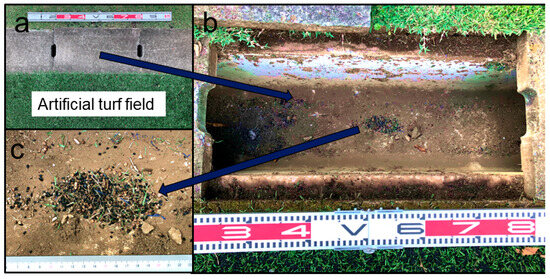
Figure 2.
(a) Top view of the ditch; (b) inside view of the ditch; (c) artificial turf fibers (green filaments) and rubber tips (black particles) in the ditch. Blue arrows indicate higher magnifications.
The lengths and widths of the fibers collected from the field (total numbers) were compared to those collected from the ditches (total numbers). The significance of the difference was tested using Student’s t-test.
2.3. Goldfish
A common variety of goldfish, Carassius auratus, was obtained from a local dealer in Tokyo and a fish wholesaler in Saitama Prefecture. We used goldfish of two different sizes to examine whether body size affects fiber ingestion. Approximately 50 large-sized fish (Tokyo) and 80 small-sized fish (Saitama) were kept in 800 L stock tanks maintained at 20 °C under a 16 h light/8 h dark (16L/8D) photoperiod (lights on at 06:00). Large fish were fed floating carp feed (Swimmy, Nippon Pet Food Co. Ltd., Tokyo, Japan) daily. The small fish were fed floating goldfish feed (Angel, Nippon Pet Food Co.) daily. All experimental fish (mixed sex) were kept in stock tanks for over one week before they were used for the experiments. All the goldfish experiments that were conducted at the ICU abided the guidelines of the Animal Experimentation Committee of the ICU. This study was approved by the Animal Experimentation Committee of the ICU.
2.4. Experiment 1 (Ingestion of Artificial Turf Fibers by Large-Sized Goldfish in the Presence or Absence of Feed)
We examined whether large-sized goldfish ingested ATFs when provided along with feed. Body weight of fish used for this experiment was 173.1 ± 34.8 g (mean and SD, N = 24). For each test, three fish (mixed sex) were transferred from the stock tank to an experimental 60 L glass aquarium and were allowed to acclimatize for three days to the tank environment and the floating goldfish feed (TetraFin, Tetra, Tokyo, Japan). The experimental aquaria were kept at 20 °C under a 16 L/8 D photoperiod (lights on at 06:00). Fish were fed 1.0 g of feed once daily. On the fourth day, the fish were categorized into one of the four groups. Fish from the experimental groups were fed a mixture of feed (TetraFin, 1.0 g) and 150 (TF1) or 300 pieces of torn fibers (TF2) collected from the field. The third group of experimental fish received 300 pieces of torn fibers without the fish feed (TF3). Fish in the control group were fed only fish feed (Control 1, 1.0 g). There were six fish in each group. Ninety minutes after the treatment, fish were anesthetized with 0.05% 2-phenoxyethanol (Wako Pure Chemical Industries, Ltd., Osaka, Japan) and dissected. The intestines were observed to determine whether the fibers were ingested. The fibers observed in the intestine of each fish were collected and counted.
The number of ingested fibers were compared among the following groups: TF1, TF2, TF3, and Control 1. The significance of the differences among the groups was compared using the Kruskal–Wallis and Steel–Dwass tests.
2.5. Experiment 2 (Ingestion of Artificial Turf Fibers by Small-Size Goldfish in the Presence or Absence of Feed)
We examined whether small goldfish ingested ATFs along with feed. Body weight of fish used for this experiment was 20.5 ± 1.9 g (mean and SD, N = 24). For each test, four fish (mixed sex) were transferred from the stock tank to an experimental 60 L glass aquarium and were allowed to acclimatize for three days to the tank environment and the floating goldfish feed (TetraFin). In our preliminary tests, the ingestion rate of small-sized fish was lower than that of large-size fish. Based on the results of the preliminary tests, we increased the number of fish of each group from six to eight in this experiment. The fish were fed goldfish feed (TetraFin, 0.5 g) once a day. On the fourth day, the fish were categorized into three groups. Fish in the first experimental group were fed a mixture of feed (0.5 g) and 300 pieces of torn fibers (TF4) collected from the field. Fish in the second experimental group received 300 pieces of torn fibers without feed (TF5). Fish in the control groups were fed only feed (Control 2, 0.5 g). There were eight fish in each group. Ninety minutes after the treatment, the fish were anesthetized with 0.05% 2-phenoxyethanol solution and dissected. The intestines were observed to identify the presence of ingested fibers.
The number of ingested fibers from each fish were collected, counted, and compared among groups TF4, TF5, and Control 2. The significance of the differences among the groups was compared using the Kruskal–Wallis and Steel–Dwass tests.
3. Results
3.1. Migration of Artificial Turf Fibers from the Field to Ditch
Artificial turf fibers were collected from six of the seven sites (Figure 1, Figure 3 and Figure 4). No fibers were collected at Site 7, where almost no sports activities were being conducted. The number of fibers collected at each site (F1–F6) and their sizes are shown in Figure 5 (length) and Figure 6 (width). All of the collected fibers were smaller in both, length, and width than their original sizes (Figure 3, Figure 5 and Figure 6). The length of the fibers at each sampling site were as follows (cm, mean ± SD, N): F1, 1.65 ± 0.61, 78; F2, 1.38 ± 0.53, 29; F3, 1.76 ± 0.57, 24; F4, 1.41 ± 0.60, 81; F5, 2.10 ± 0.62, 27; F6, 1.98± 0.41, 12. The width of the fibers at each sampling site were as follows (mm, mean ± SD): F1, 0.65 ± 0.26; F2, 0.59 ± 0.22; F3, 0.63 ± 0.27; F4, 0.54 ± 0.29, F5, 0.70 ± 0.27; F6, 0.63 ± 0.39.
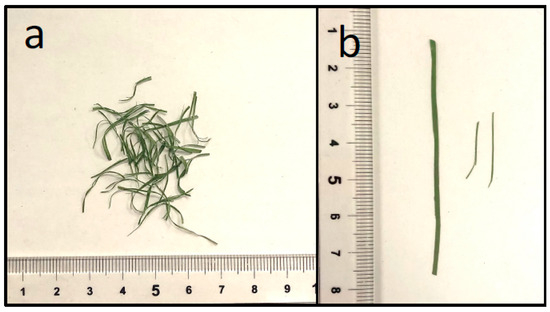
Figure 3.
(a) Artificial turf fibers collected in the field. (b) Left, a fiber of original size. Middle and right, torn fibers collected in the field.
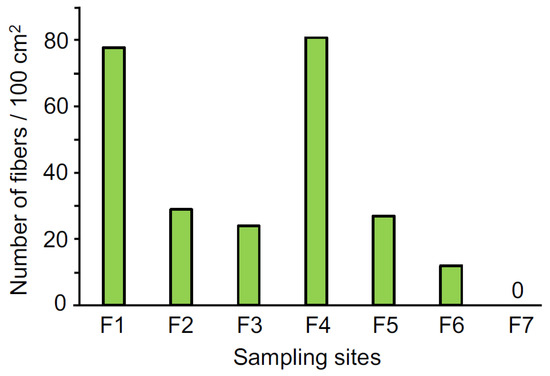
Figure 4.
Number of artificial turf fibers collected at each sampling site in the artificial turf sports field (F1–F7). No fibers were collected at F7.
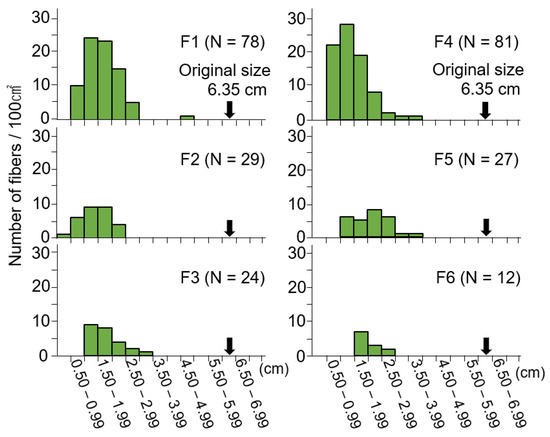
Figure 5.
Length of fibers collected at each sampling site in the artificial turf sports field (F1–F6). Original length of the fiber is indicated by arrows (6.35 cm). No fibers were collected at F7.
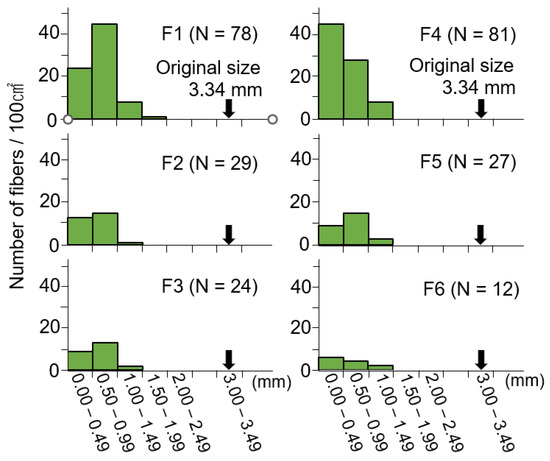
Figure 6.
Width of fibers collected at each sampling site in the artificial turf sports field (F1–F6). Original width of the fiber is indicated by arrows (3.34 mm). No fibers were collected at F7.
There were significant differences of the length of fibers among sampling sites (p < 0.05). No significant difference was observed in the width of fibers among sampling sites (p > 0.05).
Artificial turf fibers were detected at all six ditch sampling sites (Figure 2c). The number of fibers collected from the ditches at each sampling site is shown in Figure 7. The lengths of the fibers at each sampling site were as follows (cm, mean ± SD, N): D1, 1.04 ± 0.63, 30; D2, 0.82 ± 0.35, 641; D3, 0.92 ± 0.47, 78; D4, 0.69 ± 0.17, 24; D5, 1.52 ± 0.70, 14; D6, 1.74 ± 0.91, 34. The width of the fibers at each sampling site were as follows (mm, mean ± SD): D1, 0.55 ± 0.30; D2, 0.58 ± 0.33; D3, 0.81 ± 0.39; D4, 0.55 ± 0.21, D5, 1.07 ± 0.52; D6, 0.75 ± 0.40. There were significant differences of the length (p < 0.05) and width (p < 0.05) of fibers among sampling sites.
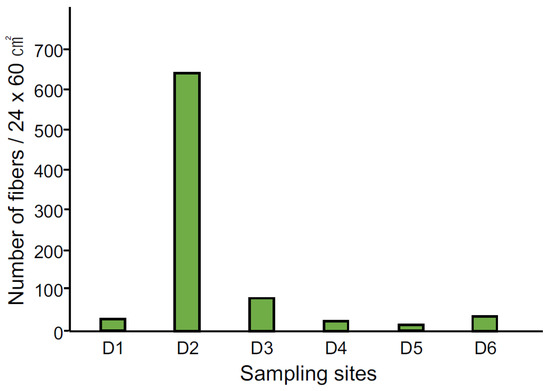
Figure 7.
The number of fibers collected at each sampling site in the ditch (D1–D6).
The lengths of fibers collected from the field and the ditch were 1.63 ± 0.72 cm (mean ± SD, N = 251) and 0.89 ± 0.52 cm (N = 821), respectively. There was a significant difference in the length of the fibers obtained from the field and those in the ditch (p < 0.001). There were no differences in the widths between the fibers in the field (0.61 ± 0.28 mm) and those from the ditches (0.62 ± 0.37 mm) (p > 0.05).
3.2. Experiment 1 (Ingestion of Artificial Turf Fibers by Large-Sized Goldfish in the Presence or Absence of Feed)
The ingestion of fibers was observed in goldfish of the two experimental groups, TF1 and TF2, but not in fish of the other groups, TF3 and Control 1 (Figure 8 and Figure 9a). Fish in the three groups (TF1, TF2, and Control 1 fed fish feed) exhibited feeding behavior toward the floating feed, but no feeding behavior was observed in fish without the feed (TF3). The number of fibers in the intestine varied from 0–5 (median, 3) in TF1 and 0–13 (median, 4.5) in TF2.
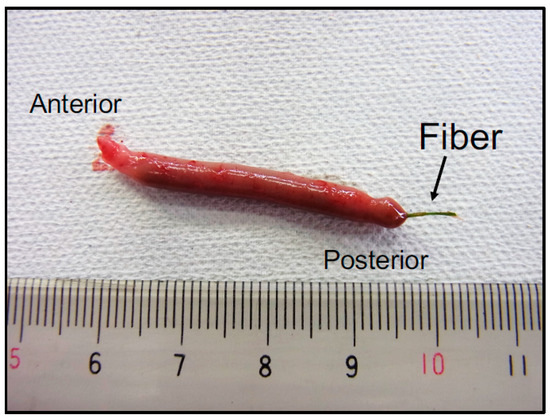
Figure 8.
Fiber of artificial turf found in the intestine of goldfish of experimental group, TF1. Fish were fed with a mixture of fish feed and fibers of artificial turf. Four fibers were collected from this fish.
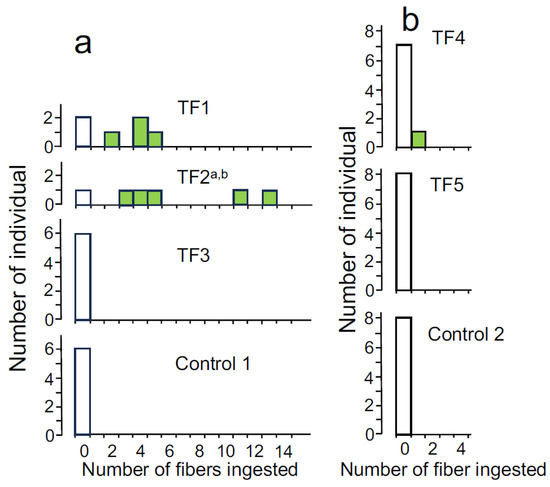
Figure 9.
(a) Ingestion of artificial turf fibers by large-sized goldfish in the presence or absence of feed. Fish were fed a mixture of feed and 150 pieces of torn fibers (TF1) or 300 pieces of torn fibers (TF2). Fish received 300 pieces of torn fibers without feed (TF3). Fish in the control group were fed feed (Control 1). (b) Ingestion of artificial turf fibers by small-sized goldfish in the presence or absence of feed. Fish were fed a mixture of feed and 300 pieces of torn fibers (TF4). Fish received 300 pieces of torn fibers without feed (TF5). Fish in the control group were fed feed (Control 2). Green color indicates the fish that ingested fibers. a TF2 vs. Control 1, p < 0.05; b TF2 vs. TF3, p < 0.05.
The number of fibers ingested in TF2 was significantly higher than that in Control 1 (p < 0.05) and TF3 (p < 0.05). There were no significant differences in the number of ingested fibers among the other groups (p > 0.05).
3.3. Experiment 2 (Ingestion of Artificial Turf Fibers by Small-Sized Goldfish in the Presence or Absence of Feed)
Ingestion of fibers was observed in one goldfish in the experimental group, TF4, but not in the fish in the other groups, TF5, and Control 2 (Figure 9b). There were no significant differences in the number of ingested fibers among the three groups (p > 0.05).
4. Discussion
The present study demonstrated that the fibers of the ATSF were torn and accumulated in the field due to players’ activities. The free fibers migrated to ditches surrounding the field, indicating the potential for the torn fibers to be released into the environment as MPs. The present study also demonstrated that goldfish ingested torn fibers, suggesting that wild fishes could ingest ATFs released into aquatic environments from artificial turf sports fields.
Marine and freshwater MPs are a global environmental issue affecting fishery activities and requires urgent measures. Our previous studies showed that ATSFs could be a source of MPs, owing to the migration of RTs from the field to the environment. These studies also showed that goldfish, crucian carp, and rainbow trout actively ingested RTs in the absence of feed under laboratory conditions [20,21].
In the present study, we focused on the fibers of an ATSF. We collected many free fibers that were smaller than their original size, both in length and width. These results indicate that free fibers were not detached from the basal cloth but were torn and split due to players’ activities and accumulated in the field over several years. Significant differences observed in the number and the length of torn fibers collected from the different sampling sites of the field were attributed to players’ activities, causing the tear of fibers and drifting of the free fibers due to wind and rain. No differences were observed in the width of the fibers collected from different sampling sites of the field.
We also collected free fibers in the ditches surrounding the field, indicating that the fibers migrated from the field to the ditches due to rain, wind, and players’ activities. The fibers collected in the ditches were shorter than those collected in the field. It is likely that the shorter fibers are lighter, migrate more easily, and are carried by wind or rain to the opening of the lid of the ditches.
There were clear differences in the number of fibers among the sampling sites in the ditches. The ATSF at the ICU has forests on the north and west sides, a baseball ground on the east side, and an open space on the south side, and hence, southeastern winds were suggested to be responsible for accumulation of a larger number of fibers in the ditch on the west side of the field (D2) compared to the other sides. The ditches were connected to sewage pipes, and the fibers in the ditches could be transported to the sewage treatment plants along with rainwater. It is possible that ATFs are torn and released into the environments from other sports fields in the same way. Significant differences were observed in the length and the width of fibers collected from different sampling sites in the ditches. However, it is not known which factors caused these differences.
Xu et al. [1] and Mahon [28] have described the flow of MPs from sewage treatment plants to the environment. Small and floating MPs are released from the treated water runoff from the plant to the river. Sinking MPs are precipitated in the sewage sludge, which is used in agriculture and in landfills. In the case of ATFs made of polyethylene, the floating fibers are released with treated water runoff into rivers and eventually reach the sea as MPs. In fact, green plastic fibers have been collected from Japanese and Indian beaches [23,24,25,26]. This type of fiber has also been found in the alimentary canals of marine fishes [27]. These fibers appear to be released from the artificial turf of sports fields or from private yards [22].
We also examined whether goldfish ingested torn fibers collected from the field. Experiments were conducted using fish of large and small body sizes. Large goldfish ingested fibers along with feed in both experimental groups, and the presence of fibers was observed in the intestines of the goldfish. In small goldfish, one out of eight ingested one piece of fiber. When goldfish were given fibers in the absence of feed, both the large and small fishes did not ingest the fibers, unlike the ingestion of RTs from the ATSF. Goldfish actively ingest RTs without fish feed [20]. The results of the present study suggest that goldfish ingested fibers unintentionally with feed when they swallowed floating feed. The results also showed a difference in ingestion rate depending on body size. The higher rate of ingestion in large fish seems to be due to the larger size of the mouth opening and stronger suction power of the fish compared to those of the small fish. This indicates that wild fishes larger than goldfish may unintentionally consume ATFs present in rivers and the sea.
According to Xiong et al. [29], goldfish exhibit ingestion preferences depending on the shape of MPs (polyethylene). Goldfish showed a higher ingestion preference for films and a lower preference for particles and filaments (fibers and lines). Since ATFs have a filamentary shape, goldfish may not have actively ingested it. However, there are many filter-feeding animals in aquatic environments, such as baleen whales, sardines, and bivalves [30,31,32] that may ingest the ATFs released into the sea. This is hazardous because the digestive enzymes cannot break down these fibers.
The retention and elimination of fibers in the goldfish intestine were not examined in the present study because the number of ingested fibers was much lower compared to RT ingestion [20]. According to the study by Xiong et al. [29], polyethylene fibers were eliminated after 72 h of ingestion in goldfish. The artificial turf fibers ingested by goldfish under the present conditions would be eliminated within several days because the fibers are soft and do not appear to stick to the intestine.
The fibers of the ATSFs used in the ICU were made of polyethylene. Although we have not studied the toxicity of ATFs in goldfish, some studies have shown the toxicity of polyethylene in several fish species, including zebrafish Danio rerio [33], gilthead seabream Sparus auratus [34], medaka Oryzias latipes [35,36], and rainbow trout Oncorhynchus mykiss [37], under laboratory conditions. These studies reported the occurrence of behavioral changes, a low growth rate, a decrease in the number of spawned eggs, changes in the microbiota of the intestine, and oxidative stress in the intestine upon ingestion of polyethylene MPs by the fish. Polyethylene fibers released into the aquatic environment from ATSFs may have an impact on wild fish species. It has also been reported that MPs in marine environments sorb and accumulate organic pollutants from the surrounding water. It has been suggested that these pollutants cause toxicity in the alimentary canals of marine animals [38].
5. Conclusions
The results of the present and our previous studies [20,21] demonstrate that ATSFs could be a source of MPs, such as RTs and ATFs. Therefore, there is an urgent need to develop countermeasures to stop the migration of RTs and ATFs from sports fields to the environment for sustainable ecosystems, fisheries, and aquaculture. There are several possible measures for reducing migration. Increasing the strength of the fibers could be an efficient measure to prevent tearing. Increasing the weight of the rubber tips prevented the tips from migrating. More directly, setting up a device to capture the migrated RTs and torn fibers would be effective. In collaboration with the Facility Management Group of the ICU, we are currently developing a device that captures RTs and ATFs. Setting up the device in sewage pipes can prevent the release of RTs and ATFs into the environment. We also plan to make an outreach effort to inform athletes, universities, professional and amateur sports associations, and companies producing sports facilities that ATSFs could be an origin of MPs. It is important to share awareness and information regarding the impact of sports activities on aquatic ecosystem among athletes, fishermen, and fish farmers [39].
Author Contributions
Conceptualization, K.T. and M.K.; methodology, K.T. and M.K.; formal analysis, K.T.; writing—original draft preparation, K.T. and M.K.; writing—review and editing, R.F., T.Y. and Y.S.; visualization, K.T. and M.K.; project administration, M.K.; funding acquisition, M.K. All authors have read and agreed to the published version of the manuscript.
Funding
This work was supported in part by Japan Society for the Promotion of Science (Grant Number 21K05786) and ICU (Grant Number AY2021-NS-BIO-001).
Data Availability Statement
The data presented in this study are available on request from the corresponding author. The data are not publicly available due to their large sample size.
Acknowledgments
We thank Company A for providing us with valuable information on the artificial turf and the fibers.
Conflicts of Interest
The authors declare no conflict of interest.
Abbreviations
| MP | Microplastic |
| ATF | Artificial turf fiber |
| ATSF | Artificial turf sports field |
| RT | Rubber tip |
References
- Xu, C.; Zhang, B.; Gu, C.; Shen, C.; Yin, S.; Aamir, M.; Li, F. Are we underestimating the sources of microplastic pollution in terrestrial environment? J. Hazard. Mater. 2020, 400, 123228. [Google Scholar] [CrossRef] [PubMed]
- Du, S.; Zhu, R.; Cai, Y.; Xu, N.; Yap, P.-S.; Zhang, Y.; He, Y.; Zhang, Y. Environmental fate and impacts of microplastics in aquatic ecosystems: A review. RSC Adv. 2021, 11, 15762–15784. [Google Scholar] [CrossRef] [PubMed]
- Xiang, Y.; Jiang, L.; Zhou, Y.; Luo, Z.; Zhi, D.; Yang, J.; Lam, S.S. Microplastics and environmental pollutants: Key interaction and toxicology in aquatic and soil environments. J. Hazard. Mater. 2022, 422, 126843. [Google Scholar] [CrossRef] [PubMed]
- Yusuf, A.; Sodiq, A.; Giwa, A.; Eke, J.; Pikuda, O.; Eniola, J.O.; Ajiwokewu, B.; Sambudi, N.S.; Bilad, M.R. Updated review on microplastics in water, their occurrence, detection, measurement, environmental pollution, and the need for regulatory standards. Environ. Pollut. 2021, 292, 118421. [Google Scholar] [CrossRef] [PubMed]
- Alberghini, L.; Truant, A.; Santonicola, S.; Colavita, G.; Giaccone, V. Microplastics in Fish and Fishery Products and Risks for Human Health: A Review. Int. J. Environ. Res. Public Health 2023, 20, 789. [Google Scholar] [CrossRef] [PubMed]
- Li, X.; Chen, Y.; Zhang, S.; Dong, Y.; Pang, Q.; Lynch, I.; Xie, C.; Guo, Z.; Zhang, P. From marine to freshwater environment: A review of the ecotoxicological effects of microplastics. Ecotoxicol. Environ. Saf. 2023, 251, 114564. [Google Scholar] [CrossRef]
- Qu, H.; Diao, H.; Han, J.; Wang, B.; Yu, G. Understanding and addressing the environmental risk of microplastics. Front. Environ. Sci. Eng. 2023, 17, 1–5. [Google Scholar] [CrossRef]
- Luo, Z.; Zhou, X.; Su, Y.; Wang, H.; Yu, R.; Zhou, S.; Xu, E.G.; Xing, B. Environmental occurrence, fate, impact, and potential solution of tire microplastics: Similarities and differences with tire wear particles. Sci. Total Environ. 2021, 795, 148902. [Google Scholar] [CrossRef]
- Chen, G.; Li, Y.; Wang, J. Occurrence and ecological impact of microplastics in aquaculture ecosystems. Chemosphere 2021, 274, 129989. [Google Scholar] [CrossRef]
- Wang, Q.; Zhu, X.; Hou, C.; Wu, Y.; Teng, J.; Zhang, C.; Tan, H.; Shan, E.; Zhang, W.; Zhao, J. Microplastic uptake in commercial fishes from the Bohai Sea, China. Chemosphere 2021, 263, 127962. [Google Scholar] [CrossRef]
- Mistri, M.; Sfriso, A.A.; Casoni, E.; Nicoli, M.; Vaccaro, C.; Munari, C. Microplastic accumulation in commercial fish from the Adriatic Sea. Mar. Pollut. Bull. 2022, 174, 113279. [Google Scholar] [CrossRef] [PubMed]
- Siddique, M.A.M.; Uddin, A.; Rahman, S.M.A.; Rahman, M.; Islam, S.; Kibria, G. Microplastics in an anadromous national fish, Hilsa shad Tenualosa ilisha from the Bay of Bengal, Bangladesh. Mar. Pollut. Bull. 2022, 174, 113236. [Google Scholar] [CrossRef] [PubMed]
- Vázquez-Rowe, I.; Ita-Nagy, D.; Kahhat, R. Microplastics in fisheries and aquaculture: Implications to food sustainability and safety. Curr. Opin. Green Sustain. Chem. 2021, 29, 100464. [Google Scholar] [CrossRef]
- Gu, H.; Wang, S.; Wang, X.; Yu, X.; Hu, M.; Huang, W.; Wang, Y. Nanoplastics impair the intestinal health of the juvenile large yellow croaker Larimichthys crocea. J. Hazard. Mater. 2020, 397, 122773. [Google Scholar] [CrossRef] [PubMed]
- Ahrendt, C.; Perez-Venegas, D.; Urbina, M.; Gonzalez, C.; Echeveste, P.; Aldana, M.; Pulgar, J.; Galbán-Malagón, C. Microplastic ingestion cause intestinal lesions in the intertidal fish Girella laevifrons. Mar. Pollut. Bull. 2020, 151, 110795. [Google Scholar] [CrossRef] [PubMed]
- Pirsaheb, M.; Hossini, H.; Makhdoumi, P. Review of microplastic occurrence and toxicological effects in marine environment: Experimental evidence of inflammation. Process. Saf. Environ. Prot. 2020, 142, 1–14. [Google Scholar] [CrossRef]
- Wang, T.; Li, B.; Zou, X.; Wang, Y.; Li, Y.; Xu, Y.; Mao, L.; Zhang, C.; Yu, W. Emission of primary microplastics in mainland China: Invisible but not negligible. Water Res. 2019, 162, 214–224. [Google Scholar] [CrossRef] [PubMed]
- Verschoor, A.J.; van Gelderen, A.; Hofstra, U. Fate of recycled tyre granulate used on artificial turf. Environ. Sci. Eur. 2021, 33, 27. [Google Scholar] [CrossRef]
- Evans, N. Sports and leisure infrastructure and applications: Styrene butadiene crumb rubber infill in artificial turf sports fields. In Tyre Waste and Recycling; Letcher, T.M., Shulman, V.L., Amirkhanian, S., Eds.; Elsevier: Amsterdam, The Netherland, 2021; pp. 483–497. [Google Scholar]
- Chiba, R.; Fujinuma, R.; Yoshitomi, T.; Shimizu, Y.; Kobayashi, M. Ingestion of rubber tips of artificial turf fields by goldfish. Sci. Rep. 2023, 13, 1344. [Google Scholar] [CrossRef]
- Kobayashi, M.; Chiba, R.; Takahashi, K.; Takemasa, J.; Fujinuma, R.; Shimizu, Y.; Yoshitomi, T. Ingestion of rubber tips of artificial sports fields by rainbow trout. J. Kanagawa Sport Health Sci. 2023, 56, 13–25, (In Japanese with English Abstract). [Google Scholar]
- Simpson, T.J.; Francis, R.A. Artificial lawns exhibit increased runoff and decreased water retention compared to living lawns following controlled rainfall experiments. Urban For. Urban Green. 2021, 63, 127232. [Google Scholar] [CrossRef]
- Fujieda, S. Distribution of small plastic debris grounded on the beach of Ise Bay. J. Jpn. Drif. Soc. 2010, 8, 1–6, (In Japanese with English Abstract). [Google Scholar]
- Asai, Y.; Zhang, D.W.; Chiba, S. Field survey of the distribution of small plastic marine debris grounded on Yoshizaki Coast of Kusu-chou, Yokkaichi-City. J. Yokkaichi Univ. 2018, 31, 125–135, (In Japanese with English Abstract). [Google Scholar]
- Karthik, R.; Robin, R.S.; Purvaja, R.; Ganguly, D.; Anandavelu, I.; Raghuraman, R.; Hariharan, G.; Ramakrishna, A.; Ramesh, R. Microplastics along the beaches of southwest coast of India. Sci. Total Environ. 2018, 645, 1388–1399. [Google Scholar] [CrossRef] [PubMed]
- Kusube, T.; Baba, Y.; Kitano, S.; Yachi, T.; Takatsuki, H. Waste survey of microplastics on the coast of Ishikawa Prefecture. Bull. Ishikawa Prefect. Univ. 2019, 2, 27–35. [Google Scholar]
- Pereira, J.M.; Rodríguez, Y.; Blasco-Monleon, S.; Porter, A.; Lewis, C.; Pham, C.K. Microplastic in the stomachs of open-ocean and deep-sea fishes of the North-East Atlantic. Environ. Pollut. 2020, 265, 115060. [Google Scholar] [CrossRef]
- Mahon, A.M.; O’connell, B.; Healy, M.G.; O’connor, I.; Officer, R.; Nash, R.; Morrison, L. Microplastics in Sewage Sludge: Effects of Treatment. Environ. Sci. Technol. 2016, 51, 810–818. [Google Scholar] [CrossRef]
- Xiong, X.; Tu, Y.; Chen, X.; Jiang, X.; Shi, H.; Wu, C.; Elser, J.J. Ingestion and egestion of polyethylene microplastics by goldfish (Carassius auratus): Influence of color and morphological features. Heliyon 2019, 5, e03063. [Google Scholar] [CrossRef]
- Besseling, E.; Foekema, E.; Van Franeker, J.; Leopold, M.; Kühn, S.; Rebolledo, E.B.; Heße, E.; Mielke, L.; Ijzer, J.; Kamminga, P.; et al. Microplastic in a macro filter feeder: Humpback whale Megaptera novaeangliae. Mar. Pollut. Bull. 2015, 95, 248–252. [Google Scholar] [CrossRef]
- Mercogliano, R.; Avio, C.G.; Regoli, F.; Anastasio, A.; Colavita, G.; Santonicola, S. Occurrence of Microplastics in Commercial Seafood under the Perspective of the Human Food Chain. A Review. J. Agric. Food Chem. 2020, 68, 5296–5301. [Google Scholar] [CrossRef]
- Chae, Y.; An, Y.-J. Effects of food presence on microplastic ingestion and egestion in Mytilus galloprovincialis. Chemosphere 2020, 240, 124855. [Google Scholar] [CrossRef] [PubMed]
- Mak, C.W.; Yeung, K.C.-F.; Chan, K.M. Acute toxic effects of polyethylene microplastic on adult zebrafish. Ecotoxicol. Environ. Saf. 2019, 182, 109442. [Google Scholar] [CrossRef] [PubMed]
- Solomando, A.; Capó, X.; Alomar, C.; Álvarez, E.; Compa, M.; Valencia, J.M.; Pinya, S.; Deudero, S.; Sureda, A. Long-term exposure to microplastics induces oxidative stress and a pro-inflammatory response in the gut of Sparus aurata Linnaeus, 1758. Environ. Pollut. 2020, 266, 115295. [Google Scholar] [CrossRef] [PubMed]
- Chisada, S.; Yoshida, M.; Karita, K. Polyethylene microbeads are more critically toxic to the eyes and reproduction than the kidneys or growth in medaka, Oryzias latipes. Environ. Pollut. 2021, 268, 115957. [Google Scholar] [CrossRef]
- DiBona, E.; Pinnell, L.J.; Heising-Huang, A.; Geist, S.; Turner, J.W.; Seemann, F. A Holistic Assessment of Polyethylene Fiber Ingestion in Larval and Juvenile Japanese Medaka Fish. Front. Physiol. 2021, 12, 668645. [Google Scholar] [CrossRef]
- Hodkovicova, N.; Hollerova, A.; Caloudova, H.; Blahova, J.; Franc, A.; Garajova, M.; Lenz, J.; Tichy, F.; Faldyna, M.; Kulich, P.; et al. Do foodborne polyethylene microparticles affect the health of rainbow trout (Oncorhynchus mykiss)? Sci. Total Environ. 2021, 793, 148490. [Google Scholar] [CrossRef]
- Endo, S.; Yuyama, M.; Takada, H. Desorption kinetics of hydrophobic organic contaminants from marine plastic pellets. Mar. Pollut. Bull. 2013, 74, 125–131. [Google Scholar] [CrossRef]
- Dingle, G.; Mallen, C. Introduction to research on sport and environmental sustainability. In Sport and Environmental Sustainability, Research and Strategic Management; Dingle, G., Mallen, C., Eds.; Routledge: Abingdon, UK, 2021; pp. 1–13. [Google Scholar]
Disclaimer/Publisher’s Note: The statements, opinions and data contained in all publications are solely those of the individual author(s) and contributor(s) and not of MDPI and/or the editor(s). MDPI and/or the editor(s) disclaim responsibility for any injury to people or property resulting from any ideas, methods, instructions or products referred to in the content. |
© 2023 by the authors. Licensee MDPI, Basel, Switzerland. This article is an open access article distributed under the terms and conditions of the Creative Commons Attribution (CC BY) license (https://creativecommons.org/licenses/by/4.0/).